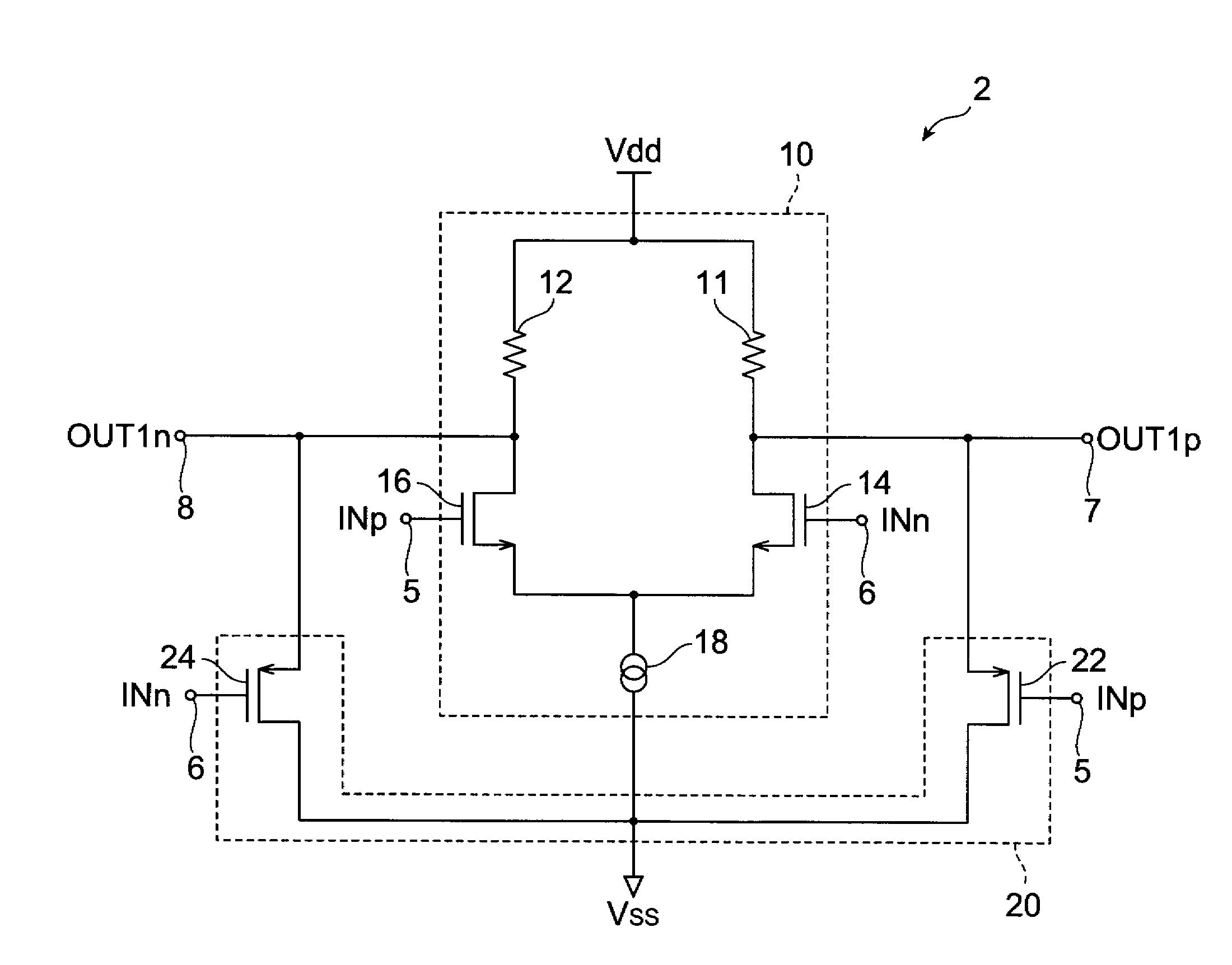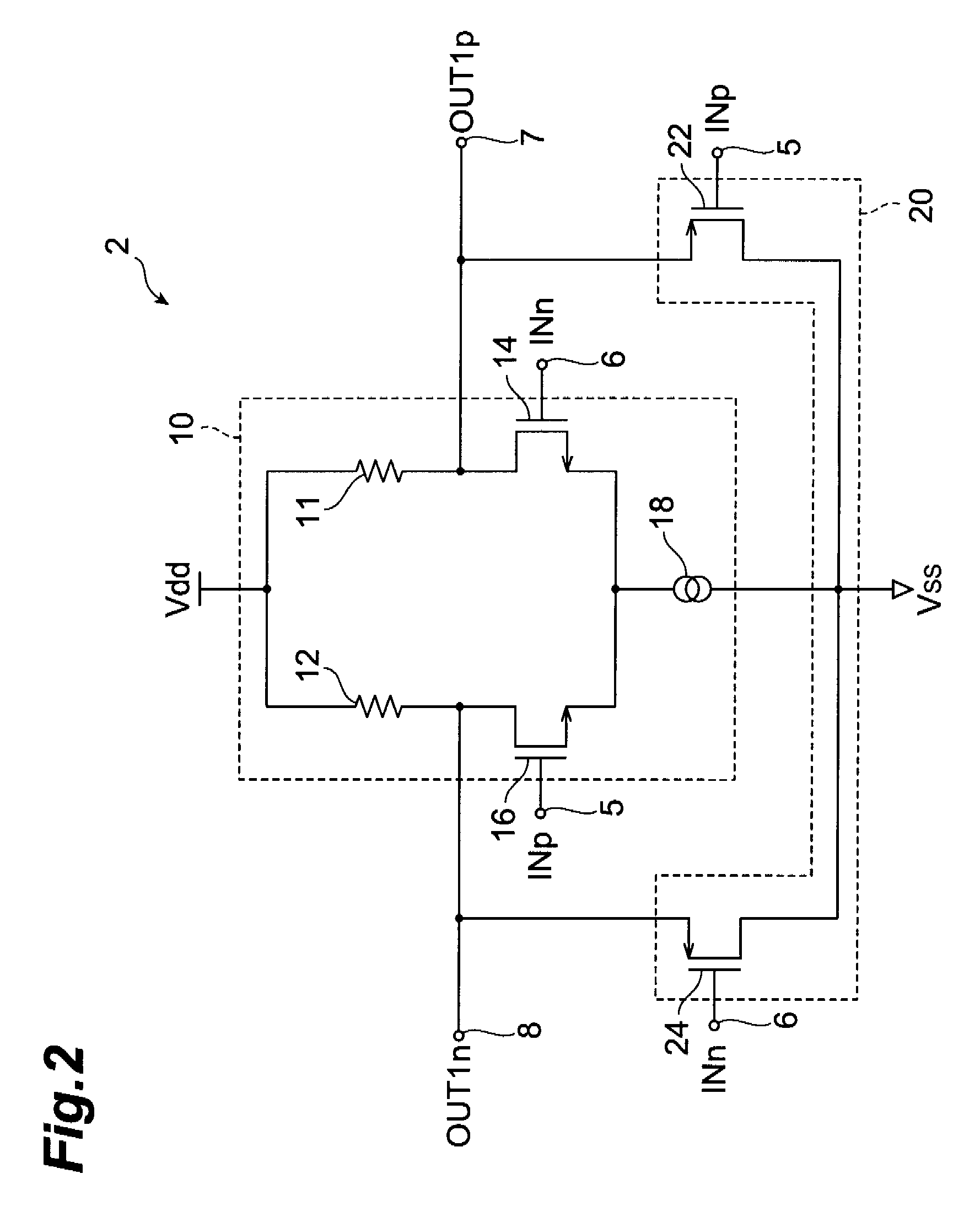Signal converting circuit
a conversion circuit and signal technology, applied in the direction of logic circuit coupling/interface arrangement, pulse technique, instruments, etc., can solve the problems of increased circuit area, increased current consumption, difficult to achieve high-speed circuit operation, etc., to achieve reduced circuit area, higher-speed operation, and reduced current consumption
- Summary
- Abstract
- Description
- Claims
- Application Information
AI Technical Summary
Benefits of technology
Problems solved by technology
Method used
Image
Examples
first embodiment
[0062]FIG. 1 shows the configuration of a rail-to-rail type differential amplifier circuit, comprising the signal conversion circuit of a first embodiment of the invention. This rail-to-rail circuit 1 is a differential amplifier circuit which acquires input signals over a broad range of common-mode voltages, performs prescribed amplification and outputs the result, and is for example used in LVDS reception device. The rail-to-rail circuit 1 comprises a signal conversion circuit 2, which converts the common-mode voltage level of input differential voltage signals, and a differential amplifier circuit 4 which amplifies the converted differential voltage signals converted to a prescribed common-mode voltage level.
[0063]Differential voltage signals INp and INn are input to the first input terminal 5 and second input terminal 6 respectively of the signal conversion circuit 2. The signal conversion circuit 2 converts the common-mode voltage level of the differential voltage signals INp an...
second embodiment
[0080]Next, a second embodiment of the invention is explained. FIG. 4 is a circuit diagram of the signal conversion circuit of the second embodiment of the invention. Similarly to the above-described signal conversion circuit 2, the signal conversion circuit 30 is a circuit used in rail-to-rail type differential amplification circuits, and converts the common-mode voltage level of input differential voltage signals into a prescribed common-mode voltage level. The differential voltage signals INp and INn are input to a first input terminal 31 and second input terminal 32, respectively, of the signal conversion circuit 30. The signal conversion circuit 30 converts the common-mode voltage level of the differential voltage signals INp and INn to the prescribed common-mode voltage level, and outputs the differential voltage signals OUT2p and OUT2n to the first output terminal 33 and second output terminal 34, respectively. The differential amplification circuit 4 shown in FIG. 1 acquires...
third embodiment
[0098]FIG. 5 is a circuit diagram showing the signal conversion circuit of a third embodiment of the invention. The signal conversion circuit 2A shown in FIG. 5 differs from the first embodiment in that, in place of the source follower portion 20 in the signal conversion circuit 2, the source follower portion 20A is comprised. Otherwise the configuration of signal conversion circuit 2A is similar to that of signal conversion circuit 2.
[0099]The source follower portion 20A differs from the source follower portion 20 in further comprising a third NMOS transistor 23 and fourth NMOS transistor 25. Otherwise the configuration of the source follower portion 20A is similar to that of the source follower portion 20.
[0100]The drain electrode of the third NMOS transistor 23 is connected to the first output terminal 7, and the source electrode of the third NMOS transistor 23 is connected to the source electrode of the first PMOS transistor 22. A first bias voltage is input to the gate electrod...
PUM
 Login to View More
Login to View More Abstract
Description
Claims
Application Information
 Login to View More
Login to View More - R&D
- Intellectual Property
- Life Sciences
- Materials
- Tech Scout
- Unparalleled Data Quality
- Higher Quality Content
- 60% Fewer Hallucinations
Browse by: Latest US Patents, China's latest patents, Technical Efficacy Thesaurus, Application Domain, Technology Topic, Popular Technical Reports.
© 2025 PatSnap. All rights reserved.Legal|Privacy policy|Modern Slavery Act Transparency Statement|Sitemap|About US| Contact US: help@patsnap.com



